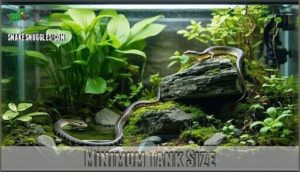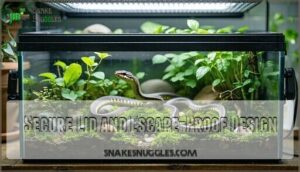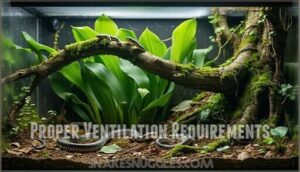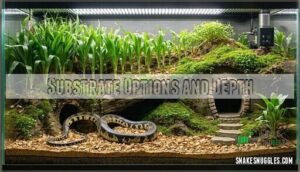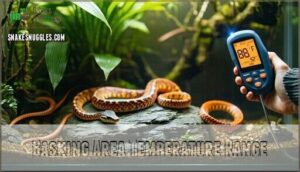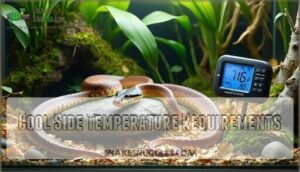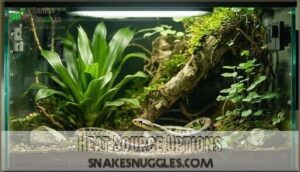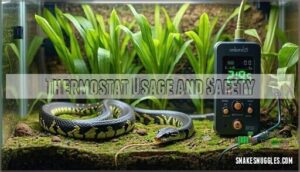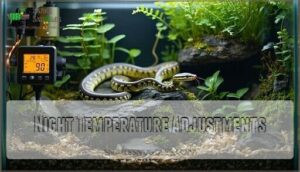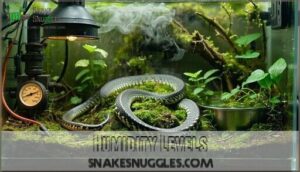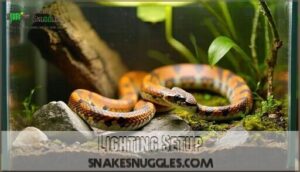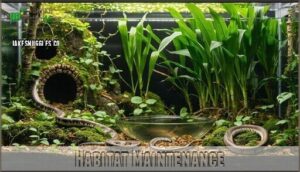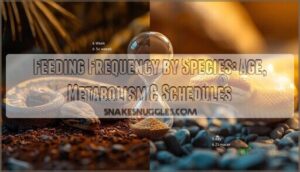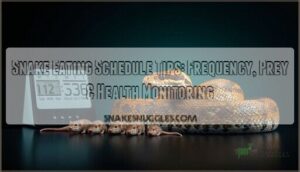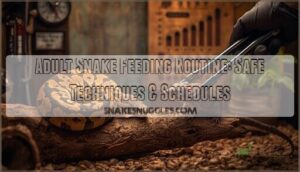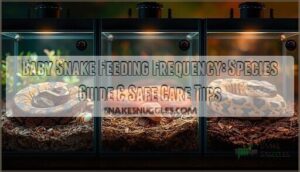This site is supported by our readers. We may earn a commission, at no cost to you, if you purchase through links.
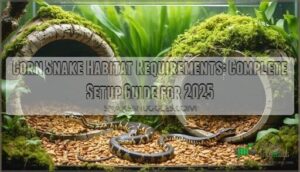 Your corn snake habitat requirements center on creating a secure 40-gallon minimum enclosure with proper temperature gradients of 78-85°F on the warm side and 70-75°F on the cool side.
Your corn snake habitat requirements center on creating a secure 40-gallon minimum enclosure with proper temperature gradients of 78-85°F on the warm side and 70-75°F on the cool side.
You’ll need 40-60% humidity, secure hiding spots on both ends, and escape-proof ventilation since these sneaky serpents can squeeze through surprisingly small gaps.
Essential equipment includes under-tank heating pads, thermostats, appropriate substrates like aspen shavings, and sturdy water bowls.
The magic happens when you balance these elements correctly, transforming a simple tank into a thriving ecosystem that keeps your scaly friend healthy and stress-free for years to come, with the right combination of elements creating a perfect environment.
Table Of Contents
- Key Takeaways
- Enclosure Requirements
- Temperature Gradient
- Humidity Levels
- Lighting Setup
- Habitat Maintenance
- Frequently Asked Questions (FAQs)
- What is the biggest trouble with corn snakes as pets?
- Do corn snakes need a tall enclosure?
- Do corn snakes need a heat lamp 24 7?
- How long should a corn snake be?
- Do corn snakes need a large enclosure?
- What is the ideal humidity range for corn snakes?
- How much space do corn snakes need?
- What is needed for corn snake habitat?
- What is the preferred habitat of a corn snake?
- What to avoid with corn snakes?
- Conclusion
Key Takeaways
- You’ll need a minimum 40-gallon tank with secure, escape-proof lids since corn snakes are notorious escape artists who can squeeze through surprisingly small gaps.
- You must create a proper temperature gradient with a warm side at 78-85°F and cool side at 70-75°F using under-tank heaters, heat lamps, or ceramic heaters controlled by reliable thermostats.
- You’ll maintain 40-60% humidity levels through strategic substrate choices like aspen shavings or cypress mulch, proper water bowl placement, and light misting when needed.
- You need to provide hiding spots on both temperature sides, climbing structures for enrichment, and follow regular maintenance schedules including daily spot cleaning and deep cleaning every 4-6 weeks.
Enclosure Requirements
Setting up your corn snake’s enclosure correctly means the difference between a thriving pet and costly vet visits down the road.
You’ll need to balance several critical factors including tank size, security features, ventilation, substrate choices, and environmental enrichment to create a habitat that keeps your snake healthy and stress-free.
This balance is crucial for creating a stress-free environment, as it directly impacts the health and well-being of your pet.
Minimum Tank Size
Choosing the right corn snake habitat starts with understanding minimum tank requirements.
Juvenile enclosures need at least 10 gallons, while adult dimensions require 30-40+ gallons minimum.
Your snake’s length determines terrarium size—enclosure length should match snake length, with width half that measurement.
Vertical space matters too, as corn snakes appreciate climbing.
However, bioactive limitations make full-size snake terrariums impractical for temporary juvenile setups.
For similar sized ball pythons, a minimum of 40 gallons is needed, which is an important consideration for snake terrariums.
Secure Lid and Escape-Proof Design
Snake enclosures need rock-solid lid security because corn snakes are notorious escape artists.
You’ll want a mesh top with sturdy locking mechanisms that can’t be pushed open from inside.
Check for gaps around the edges – even tiny spaces spell trouble since these flexible snakes can squeeze through surprisingly small openings.
Choose durable materials that won’t warp over time, compromising your terrarium’s escape prevention system.
Proper Ventilation Requirements
Your snake enclosure needs proper airflow to prevent stale air and mold growth.
Screen tops provide excellent ventilation while maintaining heat gradients. Position vents at different heights – lower on the cool side, higher on the warm side – to encourage natural air circulation.
This airflow importance can’t be overstated for preventing respiratory infections. Avoid over-ventilating, which drops humidity levels below your snake’s needs.
Vital humidity is essential, as it aids in corn snake’s skin health and supports the overall health of your snake, making it a crucial aspect of snake care.
Substrate Options and Depth
Your snake substrate choice directly impacts their health and natural behaviors.
Aspen shavings excel for burrowing and absorb moisture well, while soil-based mixes like 40% topsoil, 40% ReptiSoil, and 20% sand provide excellent moisture control.
Maintain 3-4 inches depth to support digging behavior.
Bioactive substrates offer long-term benefits but require initial investment.
Avoid pine or cedar oils.
Corn snakes also benefit from proper UVB lighting to thrive in their environment with proper care.
Hiding Spots and Climbing Structures
Beyond substrate, you’ll need hiding spots and climbing structures for your corn snake’s well-being.
Provide at least two hide boxes—one on each temperature side.
Include caves, ledges, and climbing branches for enrichment benefits.
Secure climbing structures prevent falls while naturalistic design creates spatial complexity.
Hide variety with different hideout box styles mimics wild environments and reduces stress.
Temperature Gradient
Creating the right temperature gradient is essential for your corn snake’s health and comfort.
You’ll need to establish a warm basking area at 88-92°F and a cooler retreat zone at 75-80°F to let your snake regulate its body temperature naturally.
Basking Area Temperature Range
Set your basking spot temperature between 88°F and 92°F for your corn snake habitat.
Use infrared thermometer readings to check surface temperature accurately, not air temperature alone.
Position your heat lamp 6-8 inches above the basking distance to create the ideal range.
Install thermostat control to prevent dangerous temperature spikes that could harm your snake.
Monitor this temperature gradient daily with a reliable thermometer.
Cool Side Temperature Requirements
Your corn snake’s cool side should stay between 75-80°F, creating the thermal gradient needed for proper thermoregulation.
This temperature range lets your snake move away from heat when needed, preventing overheating and supporting healthy digestion.
Use digital thermometers to monitor both sides of your corn snake habitat consistently.
The gradient impact on your snake’s health can’t be overstated—without proper cool zones, stress and illness follow.
Consistent temperatures are essential for thermoregulation benefits.
Heat Source Options
In terms of keeping your corn snake cozy, you’ve got several heating options that’ll make their habitat feel like home.
Each heat source has its own perks, so let’s break down your main choices:
- Under-tank Heaters: Gentle ground warmth perfect for belly heating
- Basking Lamps: Overhead heat that mimics natural sunlight with infrared light
- Ceramic Heaters: No-light heat sources ideal for nighttime warmth
- Radiant Panels: Even heat distribution across larger enclosure areas
For consistent heating, consider reliable reptile products.
Thermostat Usage and Safety
You’ll need a reliable thermostat to maintain proper temperature control and prevent dangerous overheating.
Digital thermostats with probe placement near your heat lamp or undertank heater offer precise temperature gradient management.
Different thermostat types include on/off and proportional models, with proportional providing smoother regulation.
Always calibrate your thermostat and consider backup systems for equipment failures.
Night Temperature Adjustments
Proper nighttime temperature drops mimic your corn snake’s natural habitat cycles.
Most keepers maintain ambient temperatures around 75°F after sunset, creating healthy seasonal variation throughout the year.
- Nighttime Drop: Lower temperatures by 5-10°F from daytime basking levels
- Seasonal Variation: Adjust settings slightly cooler during winter months
- Thermostat Settings: Program dual thermostats for day/night temperature control
- Safe Heaters: Use ceramic heat emitters or radiant heat panels for nighttime warmth
- Ambient Control: Monitor room temperature to prevent excessive cooling
Humidity Levels
Humidity control is essential for your corn snake’s health, affecting everything from proper shedding to respiratory function.
You’ll need to maintain specific humidity levels while monitoring and adjusting moisture throughout your snake’s habitat to ensure proper care.
Ideal Humidity Range
Maintaining proper humidity levels creates the foundation for your corn snake’s health and comfort.
You’ll want to keep humidity between 40-60% for daily living, with temporary increases to 70% during shedding periods.
Low humidity causes stuck sheds and respiratory issues, while excess moisture above 75% promotes scale rot and bacterial growth.
For snakes such as ball pythons, it’s vital to prevent dehydration and shedding to ensure their overall wellbeing.
Humidity Monitoring Tools
You’ll want a digital hygrometer for accurate humidity readings in your corn snake’s habitat.
Digital hygrometers provide precise measurements, while analog gauges serve as backup options.
Calibration methods guarantee accuracy over time.
Remote monitoring systems let you track humidity levels from anywhere.
Consider humidity controllers for automated adjustments when levels drift outside the ideal 40-60% range.
Misting and Moisture Retention
You’ll maintain proper humidity levels through strategic misting and smart substrate choices.
Daily light misting helps boost moisture, while choosing moisture-retaining substrates like cypress mulch creates lasting humidity.
Here’s your moisture retention toolkit:
- Misting Frequency: Light daily spraying, heavier during shedding periods
- Substrate Choice: Cypress mulch, coconut fiber, or paper towels retain moisture effectively
- Humid Hides: Moss-filled containers provide localized high-humidity zones
- Water Bowls: Large bowls on cool side increase ambient humidity naturally
- Shedding Aid: Monitor hygrometer readings and increase moisture when snake shows pre-shed signs
Addressing Low Humidity Issues
Low snake humidity below 40% creates shedding problems and dehydration.
Check your hygrometer readings twice daily to catch drops early.
| Solution | Implementation |
|---|---|
| Increase Misting Frequency | Spray enclosure walls 2-3 times daily |
| Add Humid Hides | Place moss-filled hide boxes on warm side |
| Upgrade Water Bowl | Use larger, wider dishes for more evaporation |
| Change Substrate Choice | Switch to cypress mulch or coconut fiber |
| Create Shedding Aid Station | Maintain one hide at 70% humidity levels |
Preventing Excess Moisture
Too much moisture creates a breeding ground for bacteria and respiratory problems in your corn snake.
Monitor humidity closely and adjust your setup when levels consistently exceed 60%.
Ventilation Strategies for ideal snake humidity control:
- Install additional air vents – Add mesh panels to opposite sides of the enclosure for proper airflow
- Position your water bowl placement on the cool side to reduce evaporation and humidity spikes
- Choose low-moisture snake substrate options like aspen shavings instead of cypress mulch or coconut fiber
- Reduce misting frequency to once weekly or only during shedding periods for reptile humidity management
- Use small dehumidifiers in the room if ambient moisture remains consistently high despite ventilation adjustments
Lighting Setup
Proper lighting creates a natural day-night cycle that helps regulate your corn snake’s biological rhythms and overall health.
You’ll need to balance heat sources with lighting options to create an environment that mimics their natural habitat while providing adequate visibility for monitoring your snake.
Types of Lighting Fixtures
Choosing the right lighting fixtures transforms your corn snake’s habitat from basic to brilliant.
You’ll find several reptile lighting options that serve different purposes, from providing essential heat to supporting natural behaviors.
| Fixture Type | Primary Function | Best Use Case |
|---|---|---|
| Heat Lamps | Basking warmth and light | Daytime heating and UVB delivery |
| LED Options | Energy-efficient illumination | General lighting with minimal heat |
| Ceramic Heaters | Heat without light | Nighttime warmth without disrupting Light Cycles |
| UVB Bulbs | Vitamin D3 synthesis | Supporting natural calcium metabolism |
Heat lamps work perfectly for creating basking spots, while ceramic heaters maintain nighttime temperatures.
LED fixtures offer excellent snake lighting solutions without excess heat buildup.
UVB Lighting Considerations
UVB lighting offers significant benefits for corn snake habitat wellness, though it’s not strictly essential for survival.
You’ll want to position T5 HO or T8 fixtures at proper lighting distance to create a 2.0-3.0 UVI basking area.
The right UVB spectrum supports natural basking behavior and vitamin D3 synthesis. Proper fixture placement allows your snake to self-regulate exposure, preventing overexposure while maximizing reptile lighting benefits.
Proper Light Cycle Duration
Your corn snake’s internal clock depends on a consistent 12-hour light schedule that mimics their natural diurnal rhythm.
Provide lighting for 12 hours daily, adjusting seasonally to match their wild photoperiod impact.
This light schedule supports their health benefits by regulating natural behaviors, and seasonal variation helps maintain proper circadian cycles.
Switching from longer summer days to shorter winter periods is essential for ideal wellness, as it allows the snake to adapt to the changing environment.
Mimicking Natural Light Intensity
For ideal corn snake health, you’ll need to recreate the gentle sunlight they’d experience in their natural woodland habitat.
Your lighting setup should provide a balanced light spectrum that supports their diurnal behavior while allowing for natural seasonal variation.
Here’s how to achieve proper light intensity:
- Light Spectrum: Use full-spectrum lighting that includes both UVA and UVB wavelengths
- Light Penetration: Position your basking lamp to create bright zones with gradual fade-off
- Shade Provision: Make certain adequate hiding spots are available where your snake can escape intense lighting
Nighttime Lighting Options
Your snake’s nighttime routine doesn’t require any special lighting since corn snakes naturally rest in darkness.
Skip red lights, moonlight bulbs, or infrared lamps that can disrupt their sleep cycle.
Ceramic heaters provide warmth without light if needed.
Use a thermometer to monitor temperatures, ensuring proper cooling at night.
Complete darkness mimics their natural habitat perfectly, providing the snake with a comfortable environment that includes the right amount of warmth.
Habitat Maintenance
Keeping your corn snake’s habitat clean isn’t just about aesthetics—it’s essential for preventing bacterial growth and maintaining your pet’s health.
Regular maintenance routines will help you spot potential issues early while creating a comfortable environment that mimics their natural habitat.
Daily Spot Cleaning Practices
Daily checks keep your snake’s home fresh and healthy.
Remove feces and urates immediately using paper towels or tongs to prevent bacterial growth.
Clean water spills quickly to avoid mold, and refresh water bowls every few days.
Spot any soiled substrate areas for prompt replacement, maintaining proper snake habitat cleaning standards.
Deep Cleaning Frequency and Methods
Beyond daily upkeep, you’ll need thorough snake enclosure cleaning every 4-6 weeks to maintain your corn snake’s health. A proper cleaning schedule prevents bacterial buildup and odors. A consistent cleaning schedule is essential for maintaining a thriving environment.
- Remove all substrate and decorations for complete access
- Scrub surfaces with reptile-safe disinfectant and warm water
- Rinse thoroughly to eliminate cleaning residue before reassembly
- Replace substrate with fresh bedding after everything dries completely
Waste disposal should follow local guidelines for pet waste.
Safe Cleaning Products for Reptiles
Choosing the right cleaning products for your corn snake’s habitat isn’t rocket science, but it matters more than you’d think.
You’ll want reptile-safe cleaners that won’t leave harmful residues behind after disinfection.
| Product Type | Examples | Key Benefits |
|---|---|---|
| Commercial Reptile-Safe | F10 Veterinary Disinfectant, Oxyfresh Terrarium Cleaner | Vet-approved, effective bacteria control |
| Natural Alternatives | White vinegar solution, Dawn dish soap | Non-toxic, budget-friendly cleaning |
| Chemical Disinfectants | Chlorhexidine, Hypochlorous acid spray | Strong disinfection without reptile harm |
The choice of cleaning product is crucial for maintaining a healthy environment for your corn snake, and understanding the different types of cleaners available can help you make an informed decision.
Disinfecting Procedures and Techniques
You’ll need to create a routine that eliminates harmful bacteria while keeping your snake safe from toxic residues.
Proper disinfection requires the right products, correct dilution ratios, and adequate contact time for effective cleaning.
- Mix bleach at 1:10 ratio – This concentration kills bacteria without leaving dangerous chemical residues
- Allow 10-minute contact time – Disinfectants need time to work their magic against pathogens
- Rinse thoroughly afterward – Residual chemicals can harm your snake’s sensitive respiratory system
Replacing and Refreshing Substrate
Fresh substrate isn’t just about aesthetics—it’s your snake’s foundation for health.
Replace aspen shavings every 4-6 weeks, cypress mulch every 6-8 weeks, or paper towels weekly.
Spot-clean waste immediately to prevent mold growth.
Bioactive setups require less frequent changes but need periodic rejuvenation of cleanup crews.
Monitor substrate depth at 2-3 inches for proper burrowing behavior and moisture retention.
Frequently Asked Questions (FAQs)
What is the biggest trouble with corn snakes as pets?
Corn snakes’ biggest challenge as pets is their 20+ year commitment—you’ll need consistent temperature gradients, specialized equipment, and long-term dedication that many owners underestimate when they’re young and manageable.
Do corn snakes need a tall enclosure?
Tall terrains truly benefit corn snakes since they’re natural climbers.
You’ll want taller enclosures beyond minimum standards—they appreciate vertical space for climbing branches and exploring, supporting their welfare and exercise needs.
Do corn snakes need a heat lamp 24 7?
No, you don’t need heat lamps running constantly. Turn them off at night to create a natural day-night cycle, while maintaining nighttime temperatures around 75°F using other heat sources.
How long should a corn snake be?
Adult corn snakes typically reach 3-5 feet in length, with some exceptional individuals growing up to 6 feet.
You’ll find most captive corn snakes fall within this standard range throughout their 20+ year lifespan.
Do corn snakes need a large enclosure?
You’ll need a spacious enclosure for your corn snake’s wellbeing. Adults require minimum 48"L x 24"W x 24"H tanks, while juveniles can start smaller and upgrade as they grow.
What is the ideal humidity range for corn snakes?
Keeping humidity levels on point isn’t rocket science—you’ll want to maintain 40-60% for your corn snake’s comfort.
During shedding periods, bump it up to around 70% to help the process go smoothly.
How much space do corn snakes need?
You’ll need a minimum 40-gallon tank for adult corn snakes, though bigger is better.
Juveniles can start in 10-gallon enclosures but quickly outgrow them as they reach their adult length of 3-5 feet.
What is needed for corn snake habitat?
Like building a fortress for your slithery friend, you’ll need a 40-gallon tank with temperature gradient (85°F warm, 70s°F cool).
You’ll also need hiding spots, water bowl, and proper ventilation to create their perfect sanctuary.
What is the preferred habitat of a corn snake?
You’ll want to create a warm, humid environment with proper hiding spots and climbing opportunities. Corn snakes prefer temperatures between 75-90°F with 40-60% humidity and secure shelter options.
What to avoid with corn snakes?
Prevention’s better than cure when caring for corn snakes. Avoid live prey, cedar substrates, heat rocks, cohabitation, handling during shedding, overfeeding, temperature extremes, and inadequate humidity levels for superior health.
Conclusion
Building the perfect corn snake habitat requirements is like constructing a cozy home for your scaly companion.
You’ve mastered the fundamentals: a secure 40-gallon enclosure, proper temperature gradients, ideal humidity levels, and regular maintenance schedules.
Remember, these corn snake habitat requirements aren’t just guidelines—they’re your snake’s ticket to a healthy, stress-free life.
When you maintain consistent temperatures, provide adequate hiding spots, and keep everything clean, you’re creating an environment where your corn snake can thrive for decades to come.
- https://www.visionproducts.us/blog/corn-snakes/
- https://community.morphmarket.com/t/corn-snake-care-guide/39834
- https://qualitycage.com/blogs/quality-snake-care/corn-snake-habitat
- https://www.thebiodude.com/blogs/snake-caresheets/care-guidelines-for-corn-snakes
- https://www.zenhabitats.com/blogs/reptile-care-sheets-resources/corn-snake-complete-substrate-guide

